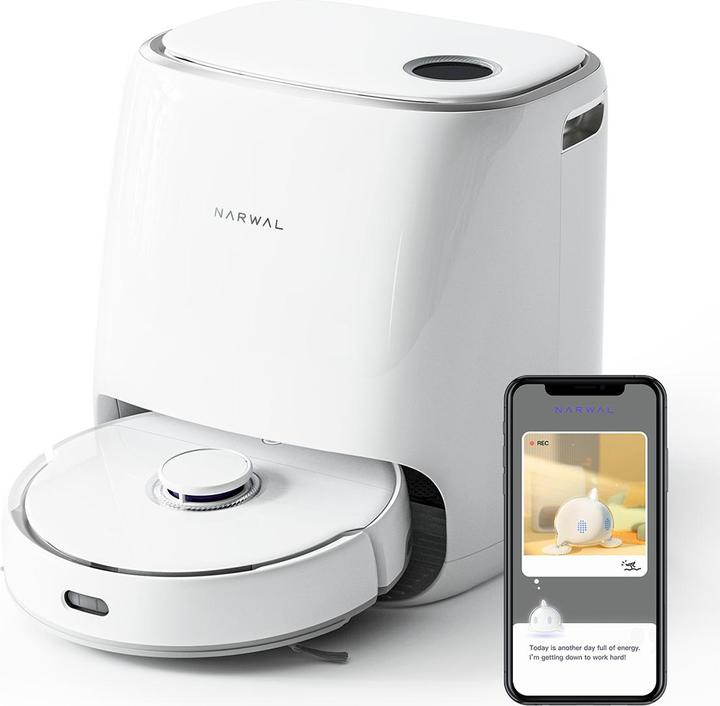

Narwhal Freo review: this new robot vacuum cleaner instantly blows me away
Quiet, fast, thorough and practically flawless, the Narwal Freo may be a newcomer on the Swiss market, but it surprised me with its great performance.
The Narwhal brand was only set up in 2016. In 2019, it launched its first robot vacuum cleaner. The manufacturer has since sold over 700,000 devices. The second model has now also made it to us in Europe.

New brands always have a hard time, especially in a market as competitive as robot vacuum cleaners. Manufacturers such as iRobot, Roborock, Ecovacs and Dreame have been extremely successful in securing large market shares. These names are joined by generalists such as Xiaomi, Dyson, Electrolux, Miele, AEG and Rowenta who also sell automatic vacuum cleaners. That accounts for there being 350 robots to choose from in our shop.
The Narwhal Freo doesn’t stand out from the crowd as being particularly good value given its price tag of 790 francs in Switzerland and 880 euros in Germany. Bear in mind the cheapest robot vacuum cleaners with a suction system, which can also mop, are available for around 450 francs. A lot of the models come in at the 600 to 800 franc range, while the top models go for between 800 to 1000 francs. The Freo’s therefore in the upper mid-range, which sets certain expectations.
Set-up: playful but fast
When you unpack the 5 cm wide, 34 cm long, 43 cm tall base station, you soon realise it’s a force to be reckoned with. It’d need to be given that it serves as a robot garage. Unlike many of its competitors, the Freo doesn’t just dock, it drives right into the station.
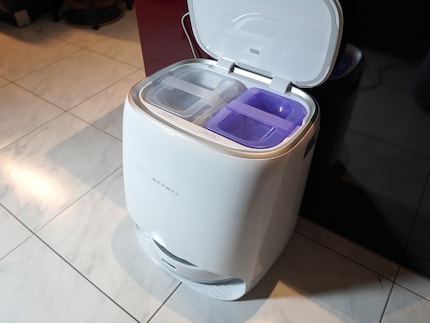
Source: Lorenz Keller
What’s also immediately noticeable is the high-quality aesthetic of both the robot and station. Obviously it’s all made of plastic, but this one is very well finished. The station looks really great with its gentle curves and silver borders. The round touchscreen at the top of the device boasts a 7 cm diameter that’s also striking. It responds incredibly fast and acts like a built-in smartphone.
As with almost all robots, it requires an app for installation with step-by-step instructions. Essentially, the robot pairs with the base station and both are also paired with the Wi-Fi network. Although only the 2.4 GHz band is actually supported, there are no issues connecting everything to a modern mesh system that also uses the 5 GHz as well as 2.4 GHz band.
Within a few minutes, everything is ready to go. The app is very playful, with Freo the Narwhal (a cartoon whale) jumping around and giving instructions via speech bubbles. But as long as everything works this smoothly, it doesn’t bother me too much.
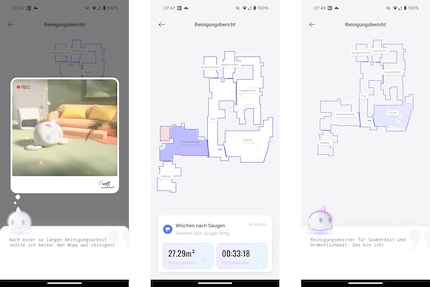
Source: Lorenz Keller
Create a home plan: scan in just 12 minutes
The second step involves scanning your home, with everything tidied away. This is what really bowls me over. The robot only needs about 12 minutes to cover around 120 square metres and 4.5 rooms. On my smartphone screen, I can see the plan of my flat being drawn up.
This is possible because Narwal uses a lidar sensor, which is installed in a dome on the device. There are also various infrared and ultrasonic sensors for close-range navigation.
But it doesn’t need this in order to create the map. The Narwhal Freo travels through the rooms so fast that if a cat was on top, they’d probably get motion sickness. It looks as though the robot is just taking a look around. The device doesn’t even need to scan the edges, as the lidar scanner recognises these from a distance.
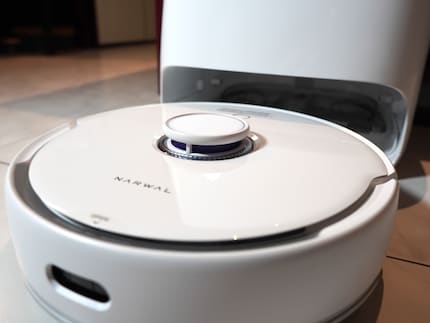
Source: Lorenz Keller
After twelve minutes, the robot drives back into its garage and I have a finished map in my app. I’m a bit skeptical at first as it’s not got all the details right. With the balcony door for instance, the scanner looked over the frame because it’s slightly raised and interpreted a small area of the balcony as a room as well.
The Freo also suggests how to divide up the rooms. As my flat has a few nooks and crannies, that didn’t work. However, it’s easy to correct this with just a few clicks. You can change the room layout and also name the rooms.
Defining no-go zones is also quick – in my case, this is where the Christmas tree currently takes pride of place. It’s a bit of a shame you can only set up rectangular zones rather than other shapes. At a push, you can simply use several rectangles. This gives you more precision to define the areas you don’t want the robot vacuum cleaner to go.
What’s very clever is that you can specify the flooring in each room. Parquet, for instance, gets mopped with less pressure, while the device doesn’t use damp pads at all on carpets.
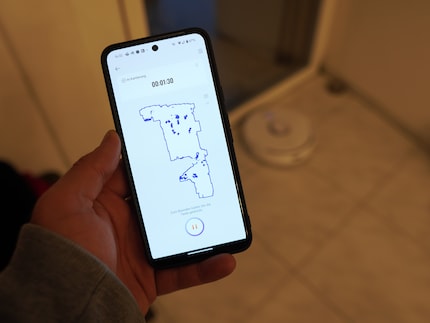
Source: Lorenz Keller
Navigation: fast and precise – the way it should be
This means the map is created incredibly fast, but not entirely accurately. Is that good enough for navigating? Yes indeed. The second time, I’m really amazed. In several weeks of testing, the Freo has never got lost or failed to find its way back to the base station.
What's more, the vacuum cleaner moves quickly and purposefully. It doesn’t need to look for where to go. Instead it just heads straight to the room it’s supposed to clean. Or from the furthest corner directly back to the base station, which it drives right into. Other vacuums sometimes need two or three attempts before parking at the docking station for charging.
The difference with the Dyson model I recently tested is striking. Comparatively, the Narwhal Freo navigates much faster and with more precision. The lidar sensor is absolutely superior to the standard camera in the Dyson 360 Vis Nav, which is twice as expensive. Often, it only cleaned individual rooms. Meanwhile, the success rate for the Freo is 100 per cent. It finds everything, doesn’t get stuck anywhere and is also reliable in making it back to the base station for a break in between.
Neatly cleaned: mopped, vacuumed or both combined
The robot offers two different cleaning methods. The first is sucking up dust and dirt. A rotating brush as well as two side brushes help push hairs and clumps of dust towards the centre. The second cleaning method involves the two triangular mops on the back that interlock. They’re always kept slightly damp for mopping the floor and ensure the entire surface is cleaned thanks to their special shape.
If you want to clean an area, you can determine exactly how you want it done. In Freo mode, the device vacuums and mops simultaneously. What’s more, the back of the robot swings against the edges of walls and furniture to make sure every bit is cleaned. The sensors detect extremely dirty areas and, where necessary, clean them a second time.
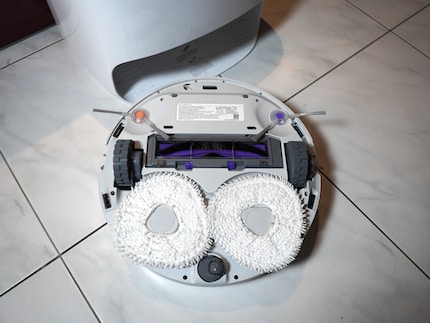
Source: Lorenz Keller
This mode is particularly thorough, but it does also take a lot longer. What really takes a while is giving the edges a precise clean. If you want to go faster, you can also simply let the robot go through your home in vacuuming and mopping mode – without special edge cleaning.
I often used the mop after vacuuming mode when I was putting it through its paces. At first, the robot just goes round the room vacuuming. Only then does it go back over it and pick any muck up with a damp mop. You can also choose to just vacuum or just mop.
Even though the Freo has less suction power than some more expensive models, it’s still by far enough. I’m extremely satisfied with the results, as it removes day-to-day dirt easily. If you use the robot regularly, all you need to do is clean crevices and corners that the device can’t get to by virtue of its design.
Advantages of this system
If you use its mops, the Freo needs to return to its base station regularly so the pads can be cleaned and dampened for the next use. It works perfectly and doesn’t take long at all. In my case, the system usually initiated going back to base for a refresh after 20 to 30 square metres. This means the mops are always clean enough that they’re not just spreading or smearing dirt around.
The base station itself contains two tanks, each with a capacity of 4.5 litres – which is why the unit is quite bulky. You fill one tank with fresh water and it collects dirty water in the other. The system notifies you via the app when it needs you to be its servant and deal with the tanks.
You also have the option to use a floor detergent. Narwhal includes some with your device. You turn the bottle upside down and place it on the station. However, this also means you can only use the manufacturer’s own detergent. Alternatively, you can switch off the feature or add just a little bit of product to the water. It’s difficult to refill the bottle yourself as you can’t remove the cap.
In terms of the pads, they get cleaned really well in the base station. They even get dried with hot air after a cleaning session. After several weeks of continuous use, they still almost look as good as new. You can also easily remove and wash them, but I didn’t need to do that during the three-week test period.
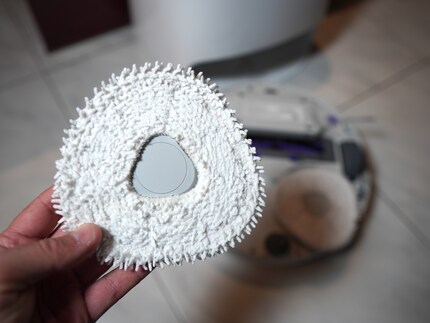
Source: Lorenz Keller
What I also like is that the Freo is extremely quiet. When I stand right next to it, I measured about 58 to 62 decibels. So it won’t disturb you if it’s cleaning in the same room.
Meanwhile, the battery life is excellent. I was able to vacuum the entire flat on a single charge. Equally, there aren’t any wait times when you choose the combination of vacuuming and mopping, as it automatically recharges when the pads are getting cleaned.
But the Narwhal Freo also has a few flaws
The main disadvantage of the system is that the base station can’t vacuum up any of the dust the device has just collected. Instead, you need to remove this manually from the dirt container. It’s a bit cumbersome because it means pulling the robot out of the garage by hand. Then opening the lid and emptying the container into the tub before pushing the Freo back into its station. Having a button on the station that would at least allow the robot to move in and out automatically would’ve been practical.
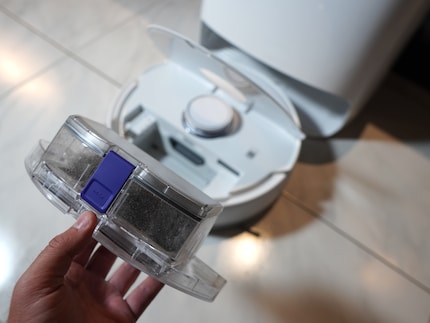
Source: Lorenz Keller
Another thing you shouldn’t underestimate is how tall the robot is because of its sensor. The device is actually just over 10.5 cm. This means any furniture such as sofas or beds should have at least 11 cm of clearance so the Freo can clean underneath.
Incidentally, you can also control a lot of features directly via the touchscreen on the base station. Or you can use the app, which offers a huge array of options but is a little too complex. For example, it always took two or three clicks more than I actually needed to access the frequently used section in order to clean a room in a certain way.

Source: Lorenz Keller
Verdict: unfamiliar brand, but really good
The Narwhal brand barely means anything to anyone at the moment. But that could change quickly. Given its only the company’s second model, the Freo is already incredibly well developed. What’s particularly impressive is how reliably the robot navigates and cleans. You simply start it and let it do the job.
Overall, the price is very fair considering you get a lot of features and good quality. Without a doubt, the biggest downside is having to empty the dirt into the tub by hand. Some of the brand’s competitors vacuum out the dust container automatically. These robots are a lot more autonomous. With the Freo, you’ll likely have to lend a hand once a week.
Overall, this newcomer to the market has no teething problems and is definitely a valid alternative to established brands. It’s especially ideal if you don’t just want to clean the whole flat but want to target specific areas again and again.
Header image: Lorenz KellerGadgets are my passion - whether you need them for the home office, for the household, for sport and pleasure or for the smart home. Or, of course, for the big hobby next to the family, namely fishing.



